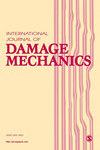Mechanistic modeling and pull-off experimental validations of fatigue damage at bitumen–aggregate interfaces
IF 3.9
2区 工程技术
Q2 MATERIALS SCIENCE, MULTIDISCIPLINARY
引用次数: 0
Abstract
Research on bituminous material fatigue has traditionally focused on tensile or shear damage of bitumen and asphalt mixtures, neglecting the critical bitumen–aggregate interfaces where microcracks initiate. Addressing this gap, the pull-off fatigue crack (POF-C) model was built to predict crack propagation at these interfaces under pull-off cyclic loading. The model, based on continuum damage mechanics principles, integrates force equilibrium and dissipated strain energy equilibrium. Pull-off fatigue tests were conducted on interfaces using limestone, tuff, and basalt aggregates, with #70 matrix bitumen and styrene–butadiene–styrene copolymer-modified bitumen, at temperatures of 15°C and 20°C, and with bitumen film thicknesses ranging from 0.2 mm to 0.8 mm. Dynamic modulus and phase angle data informed the model inputs. Predicted crack sizes closely matched measured results on fractured surfaces, demonstrating less than 2% prediction error. Scanning electron microscope tests confirmed the model's validity, showing numerous circular mesh depressions on fracture surfaces. The POF-C model accurately forecasts POF-C lengths across varied conditions, revealing three distinct stages of crack propagation: a rapid growth (∼0.025 mm/cycle), a stable expansion stage (<0.025 mm/cycle), and a slow fatigue stage (∼0 mm/cycle). The fatigue mechanism involves the development of microdamage into microcracks, their nucleation and aggregation, and macrocrack throughout the entire bitumen–aggregate interface.沥青-骨料界面疲劳损伤力学建模及拉脱试验验证
传统的沥青材料疲劳研究主要集中在沥青和沥青混合料的拉伸或剪切损伤上,而忽略了产生微裂纹的关键沥青-骨料界面。为了解决这一问题,建立了拉脱疲劳裂纹(POF-C)模型来预测拉脱循环载荷作用下这些界面处的裂纹扩展。该模型基于连续损伤力学原理,综合了力平衡和耗散应变能平衡。在温度为15°C和20°C,沥青膜厚度为0.2 mm至0.8 mm的条件下,采用石灰石、凝灰岩和玄武岩集料,采用#70基质沥青和苯乙烯-丁二烯-苯乙烯共聚物改性沥青,在界面上进行了拉脱疲劳试验。动态模量和相位角数据为模型输入提供信息。预测的裂缝尺寸与断裂表面的测量结果非常吻合,预测误差小于2%。扫描电镜测试证实了该模型的有效性,在断口表面显示了许多圆形网格凹陷。POF-C模型准确地预测了不同条件下的POF-C长度,揭示了裂纹扩展的三个不同阶段:快速扩展阶段(~ 0.025 mm/循环),稳定扩展阶段(<;0.025 mm/循环)和缓慢疲劳阶段(~ 0 mm/循环)。其疲劳机制包括微损伤发展为微裂纹、微裂纹的成核和聚集,以及贯穿整个沥青-骨料界面的宏观裂纹。
本文章由计算机程序翻译,如有差异,请以英文原文为准。
求助全文
约1分钟内获得全文
求助全文
来源期刊

International Journal of Damage Mechanics
工程技术-材料科学:综合
CiteScore
8.70
自引率
26.20%
发文量
48
审稿时长
5.4 months
期刊介绍:
Featuring original, peer-reviewed papers by leading specialists from around the world, the International Journal of Damage Mechanics covers new developments in the science and engineering of fracture and damage mechanics.
Devoted to the prompt publication of original papers reporting the results of experimental or theoretical work on any aspect of research in the mechanics of fracture and damage assessment, the journal provides an effective mechanism to disseminate information not only within the research community but also between the reseach laboratory and industrial design department.
The journal also promotes and contributes to development of the concept of damage mechanics. This journal is a member of the Committee on Publication Ethics (COPE).
 求助内容:
求助内容: 应助结果提醒方式:
应助结果提醒方式:


